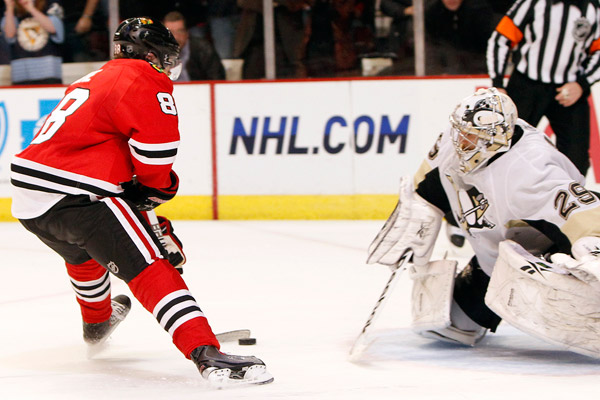
I'm not a hockey fan. I can't skate, and am still embarrassed by the one time I tried. I grew up in a place with barely what any sensible person would call hockey: Slap Shot, redone as tragicomedy with vein of Southern Lost Cause B.S. But in recognition of the fact that I'm probably in Chicago for awhile, and as a way of killing time until baseball season starts, I vaguely committed to a multiyear process of hockey appreciation, beginning with a subscription to NHL's Gamecenter and a copy of Ken Dryden's The Game (which has more about Quebecois separatism than I expected).
I still don't get it; I still have to rewind plays over and over just to see how the puck gets in the net. But I'm puzzling through it. And one of the first things I had to puzzle through was the shootout charity point, which Eric Zorn wrote about recently in the context of the Blackhawks streak, which does sound a little funny when you think about it:
[B]ecause all three of the [Blackhawks'] losses have been in post-overtime period shootouts, their record is listed as 18-0-3, and folks are gushing about how the Hawks have earned at least one point in all 21 games this season, a record start.
Fine, but baseball doesn't reward teams that lose in extra innings. Basketball and football don't give an extra atta-boy to teams that come up short in overtime.
It is… weird, if you're coming to hockey from another sport. And weird, too, for traditionalists, an instinct I completely understand as a lifelong baseball fan, a crucial aspect of which is having inexplicably stubborn opinions about the sanctity of the rules. Traditionalists tend not to like stunts designed to sucker bandwagoneers like myself.
But I got suckered, by Kaner. (Not yet? Patrick Kane? Sorry, still figuring out the bandwagon.) Kane's balletic little two-step against Jimmy Howard—who'd been playing beautifully—to beat the Red Wings was exquisite, like an end-zone dance that mattered.
Perhaps later I'll rail against the injustices of the shootout, but for now I am impressed by pretty things. And it seems less silly than soccer shootouts, as "honorary Canadian" Adam Gopnik explains:
Just think about the difference between taking a penalty in soccer and the shootout in hockey. The penalty in soccer is something that academic game theorists have actually looked at in detail: what’s the best technique, they ask, the optimal strategy for the shooter in soccer to pursue when he’s got a penalty shot to take? It’s a play of minds, because the goalkeeper has to anticipate what the shooter will do, and the shooter, the goalkeeper. Shoot left? Shoot right? High? Low? And the theorists have discovered that the optimal strategy is . . . just to blast away. The goal is so big and the goalkeeper so small that the shooter is much better off just blasting to the middle rather than trying to pick a corner.
[snip]
In the shootout in hockey, you have exactly the same confrontation between shooter and goalkeeper, but the shooter just blasting away or the goalie staying in place is never going to work. There are just too many dimensions in play—the shot takes place in depth and in motion, not from a fixed spot—and the odds between goalie and shooter are too closely matched. The shootout in hockey puts a premium on having a hole card: an idea, a strategy, a plan in advance, unknown to the opposition. And the goalie needs to respond to that kind of strategic initiative, that kind of creativity, with aggressive anticipation. The obvious play, which benefits you in a sport such as soccer, penalizes you in hockey.
All well and good, but traditionalists find the idea of a shootout offensive, not to mention the charity point given to the loser for not losing during the "real" game, something teams have exploited by playing for a tie:
Teams seem to have figured out that dragging 10 games to the shootout is as good as winning five more games in regulation and can vault a team into the playoffs.
[snip]
Initially, NHL teams didn't take advantage of this extra point: in 2005-06, the first year of the shootout, the percentage of tie games after overtime hit a 12-year low. But 40% of the way through this season, the rate is at an all-time high, along with the percentage of games going into overtime.
A tie game is largely foreign to traditional American sports (it's possible in football, but sufficiently rare that Eagles quarterback Donovan McNabb didn't know it was possible). But there's something elegant about the idea:
Weinstock argues that sport serves both a civilizing function (by sublimating aggressive tendencies) and as a school for lessons in in-group/out-group morality. Furthermore, he says that the notion that there must always be winners and losers is a bad life lesson. Often, life has results that are indeterminate or uncertain, with no clear winner or loser. Or as Adam Gopnik put it, in a lovely New Yorker essay on soccer and life he wrote during the 1998 World Cup in France, “nil-nil is the score of life”.
I tend to be wary when someone says something is "civilizing": you know, like a beer-soaked Cubs game or, say, German classical music. But I still like the idea of the charity point as an alternative to the binary win-loss form of the sports I grew up with. It rewards a well-played game, like the Red Wings shutting down the Hawks behind a virtuoso performance from Howard, but offers the compromise of a satisfyingly tense mano-a-mano showdown. And if it's a dumb populist kludge—well, that's the score of life too.
Photograph: Chicago Tribune


